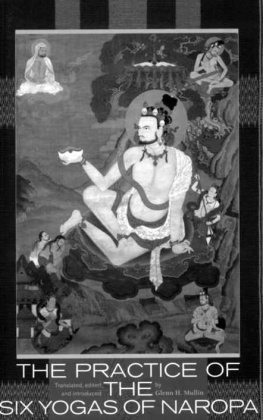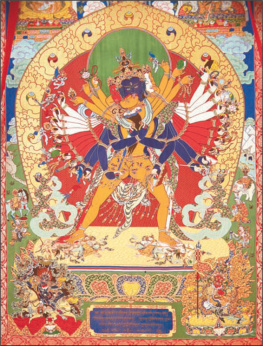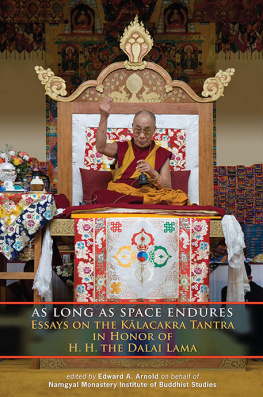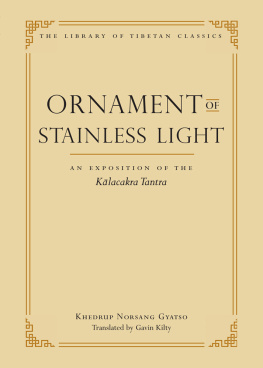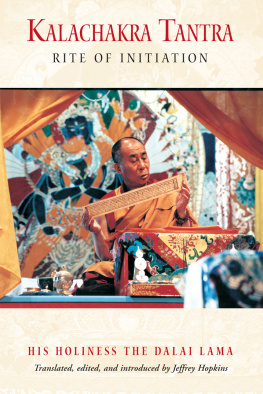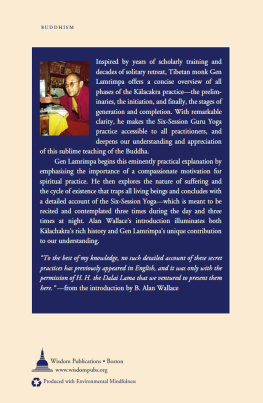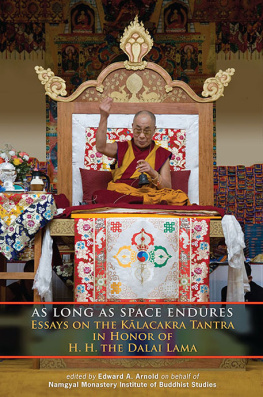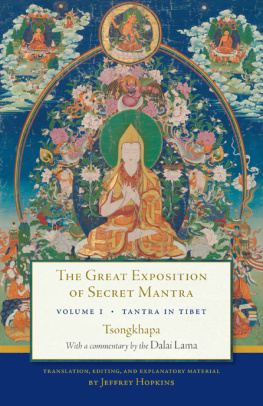by Glenn H. Mullin
Foreword by H. H. the Dalai Lama
P.O. Box 6483
Copyright 1991 Glenn H. Mullin
All rights reserved. No part of this book may be reproduced by any means without prior written permission from the publisher.
Mullin, Glenn H.
The practice of Klachakra / by Glenn H. Mullin : with
by H.H. the Dalai Lama.
p. cm.
Includes bibliographical references.
1. Klachakra (Tantric rite) I. Title.
[Page 8.] Drawing by Alexander Kocharov
[Page 128.] Drawing by Alexander Kocharov
[Page 146.] Drawing by Alexander Kocharov
[Page 216.] Drawing by Robert Beer
[Page 257.] Drawing by Sidney Piburn
[Page 264.] Drawing by Robert Beer
[Page 280.] Drawing by Robert Beer


FOREWORD
All teachings given by the Buddha have as their essential purpose the taming and transformation of the mind. The Buddhist view is that when we improve the quality of our mind, our wisdom, not only do we benefit ourselves in the most lasting and pervasive sense, but indirectly we also greatly benefit all other sentient beings. Training the mind is the key to achieving lasting inner peace and happiness.
The spiritual path can be likened to building a house. Even though we might like to begin by erecting the walls or roof, in fact we must first put in the foundations.
Similarly, when we approach the task of transforming the mind we have to begin by establishing a firm foundation. We may feel that because the real enemies of sentient beings are our own delusions, we should immediately apply the most powerful antidote in order to totally remove them from their source. However, the transformation of the mind is one undertaking that can only be accomplished in stages. We must begin at the beginning.
The first step is to cultivate the intention to avoid engaging in negative, harmful, self-destructive ways of body, speech and mind. This creates an inner environment wherein we can accomplish the second step, which is the elimination of the delusions. Thirdly, we attempt to extract the very seeds or imprints of delusion.
For this reason the Buddhist path begins with cultivating the three higher trainings of self-discipline, meditative concentration, and the wisdom understanding emptiness. When these three have been made firm one can take up the methods of the bodhisattva path, in which one cultivates the aspiration to achieve highest enlightenment for the benefit of all sentient beings, and on the basis of that aspiration engages in the six perfections of generosity, self-discipline, patience, effort, meditative stabilization, and wisdom. Finally, these methods can be complemented with the tantric practices, which begin with the receiving of the initiations and tantric commitments, and involve the powerful trainings of the generation and completion yogas.
In this way we can gradually build the house of a spiritual practice having the potency to totally uproot the delusions, and to transport the mind to the state of final enlightenment.
Tantric practice is more powerful than the general sutra trainings for a number of reasons. One of these is that it fully integrates the factors of method and wisdom. In the sutra path one meditates on emptiness, or the non-inherent existence of phenomena, within the framework of the compassionate aspiration to highest enlightenment. Meditation on emptiness is the factor of wisdom, and the bodhisattva aspiration is method. However, in the sutra path these two cannot be generated simultaneously within one moments consciousness by a practitioner on ordinary levels. In the tantric path, as method one generates the mandala and deities, and then focuses on their empty nature. In this way method and wisdom arise simultaneously in the entity of one mind.
In buddhahood, method and wisdom, body and mind, are of one taste. The tantric path utilizes this dynamic from the very beginning, and thus produces a far more rapid enlightenment. The exclusive nature of the tantric path is that it brings an important aspect of the result of practice - ie., the integral character of buddhahood - into the structure of our training right now. The meditation is performed with awareness of emptiness, and it is that consciousness focused on emptiness which is generated in the form of the mandala deities. This is a feature of all four classes of tantras. In highest yoga tantra this principle is taken even further, with the practitioner utilizing the most subtle levels of bodily energies and of consciousness, levels inaccessible to the untrained person.
Here the clear light mahamudra is taken as the exclusive substantial cause of a Buddhas wisdom-truth body. Through bringing clear light mahamudra into the path, sudden enlightenment becomes possible. This most subtle technique is found only in highest yoga tantra.
In general, an understanding of a spiritual method is itself a blessing; but in order to enter the tantric path it is said to be necessary to first receive the blessings of the initiation ceremony from a qualified master holding an unbroken lineage of transmission. This empowers one to enter into the tantric yogas, and plants the seeds for future realization.
Later, when one engages in the generation and completion stage yogas, one must rely upon a qualified teacher in order to apply the powerful tantric methods successfully. The traditional scriptures advise us to choose a teacher carefully, using reason and wisdom as our tools, and not to rely on blind faith. Moreover, even though we are advised to maintain respect and faith in the teacher, this too must be done on the basis of common sense; should an instruction of our teacher contradict what we know of Dharma, we should respectfully and politely voice our qualms, and not just mindlessly acquiesce. As the glorious Indian master Nagarjuna pointed out, faith must always be guided by intelligence and wisdom.
There are several different views as to the exact time when Buddha first gave the Kalachakra teaching. The Second Dalai Lamas guru, Khedrub Norzang Gyatso, and other lamas like Taktsang Lotsawa, conclude that Buddha taught it a month before he passed away. Another view is that it was given the year after his enlightenment. Both of these groups have well-developed theses to support their views on the subject, based on diverse sources.
Nonetheless, both accept that the transmission was carried from India to Shambhala soon after it was taught, and that it remained there until the master Chilupa retrieved it.
The system was brought to Tibet in two separate lines, known as the Dro and Rva Traditions. Later these were united by the omniscient Buton Rinchen Drub. It was from Butons immediate disciple Chokyi Pel that Je Tsongkhapa received the transmission.



